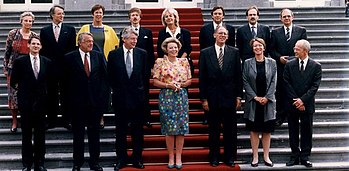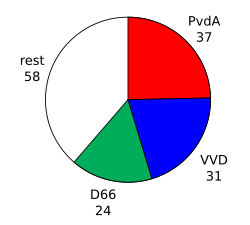First Kok cabinet First Purple cabinet | |
|---|---|
Cabinet of the Netherlands | |
  The installation of the first Kok cabinet on 22 August 1994 | |
| Date formed | 22 August 1994 |
| Date dissolved | 3 August 1998 (Demissionary from 6 May 1998) |
| People and organisations | |
| Head of state | Queen Beatrix |
| Head of government | Wim Kok |
| Deputy head of government | Hans Dijkstal Hans van Mierlo |
| No. of ministers | 14 |
| Member party | Labour Party (PvdA) People's Party for Freedom and Democracy (VVD) Democrats 66 (D66) |
| Status in legislature | Centrist Majority government (Grand coalition/Purple) |
| History | |
| Election | 1994 election |
| Outgoing election | 1998 election |
| Legislature terms | 1994–1998 |
| Incoming formation | 1994 formation |
| Outgoing formation | 1998 formation |
| Predecessor | Third Lubbers cabinet |
| Successor | Second Kok cabinet |
| Part of the Politics series |
![Azure, billetty Or a lion with a coronet Or armed and langued Gules holding in his dexter paw a sword Argent hilted Or and in the sinister paw seven arrows Argent pointed and bound together Or. [The seven arrows stand for the seven provinces of the Union of Utrecht.] The shield is crowned with the (Dutch) royal crown and supported by two lions Or armed and langued gules. They stand on a scroll Azure with the text (Or) "Je Maintiendrai" (French for "I will maintain".)](http://upload.wikimedia.org/wikipedia/commons/thumb/8/8f/State_coat_of_arms_of_the_Netherlands.svg/150px-State_coat_of_arms_of_the_Netherlands.svg.png) |
|---|
|
|
The first Kok cabinet, also called the first Purple cabinet was the executive branch of the Dutch government from 22 August 1994 until 3 August 1998. The cabinet was formed by the social-democratic Labour Party (PvdA), the conservative-liberal People's Party for Freedom and Democracy (VVD), and the social-liberal Democrats 66 after the election of 1994. The cabinet was a centrist grand coalition and had a substantial majority in the House of Representatives with Labour Leader Wim Kok serving as Prime Minister. Prominent Liberal politician Hans Dijkstal served as Deputy Prime Minister and Minister of the Interior, while Progressive-Liberal Leader Hans van Mierlo served as Deputy Prime Minister and Minister of Foreign Affairs.
The cabinet served during the economic expansion of the 1990s. Domestically, it was able to implement several major social reforms such as legalizing euthanasia and had to deal with the fallout of the El Al Flight 1862 crash. Internationally, the signing of the Treaty of Amsterdam took place, but it also had to deal with several crises such as the Bosnian War. The cabinet suffered no major internal conflicts, completing its entire term, and was succeeded by a continuation of the coalition in the second Kok cabinet following the election of 1998.[1]
- ^ "De formatie van Paars 1: een heidens karwei" (in Dutch). Andere Tijden. 3 September 2002. Retrieved 26 January 2018.